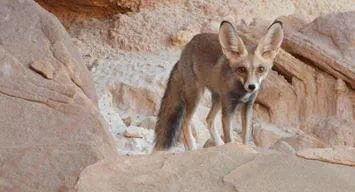Endangered Species Day
A day for endangered species: ‘Wildlife is important to the quality of life of humans’

Global May 18, 2023
Endangered Species Day serves as an annual reminder of the urgent need to protect endangered species and the ecosystems that sustain them.
We share our planet with an estimated 8.7 million species, but we have only officially identified and described about 1 million species, meaning many are yet to be identified, such as the recently discovered nano-chameleon Brookesia nana, which is the size of a sunflower seed, or the stream tree frog Hyloscirtus tolkieni, which a single specimen was discovered this year.
Declining biodiversity
Despite this incredible diversity and the promise of discovering millions more species, the conservation status of many is in poor health. Of the 150,300 species listed on the IUCN Red List, 42,100 are threatened with extinction.
This includes:
- 41% of amphibians
- 37% of sharks and rays
- 36% of reef building corals
- 34% of conifers
- 27% of mammals
- 13% of birds.
It has been estimated that animal species have declined by an average of 70% globally since 1970, and the rate at which species are becoming extinct is accelerating as a result of human actions.

Endangered Species Day
Still, we have cause to celebrate the diversity of life on Earth, and Aramco will be joining others on May19 to observe Endangered Species Day and help raise awareness about the importance of protecting threatened and endangered species, celebrating successful conservation efforts to preserve them.
Despite being on one the world’s great “flyways” (migration routes) and the rich coastal waters of the Red Sea and the Arabian Gulf supporting diverse coral reef and sea grass ecosystems, the Kingdom is not immune to the global biodiversity crisis.
According to the IUCN, 147 species in Saudi Arabia are near threatened, 113 are vulnerable, 40 are endangered, 16 are critically endangered, three are regionally extinct (Asiatic Wild Ass Equus hemionus, Cheetah Acinonyx jubatus, and Lion Panthera leo), one (the Arabian Oryx Oryx leucoryx) was extinct in the wild (but has since been reintroduced), and one (the regionally endemic Saudi Gazelle Gazella saudiya) is globally extinct.
Of the 21 extant endemic species in the Kingdom, only one is listed as least concern, and none are stable or increasing.

Of the 401 bird species recorded in Saudi Arabia, 102 are listed as species of high conservation. The Asir Magpie Pica asirensis is considered to be one of the bird species of highest conservation priority due to its endangered status (both globally and regionally), its small and decreasing population size (perhaps 100 pairs), small range (about 3,000 km²), and the fact that its global population occurs entirely within the Kingdom.
Similarly, the coastal waters of the Red Sea and the Arabian Gulf are teeming with life, with diverse coral reefs and critically important sea grass beds sustaining species of high conservation priority such as hawksbill turtle Eretmochelys imbricate and the dugong Dugong dugon. The hawksbill turtle is listed as critically endangered on the IUCN Red List, and the dugong is listed as vulnerable and populations of these species are declining.
Our conservation efforts
Aramco, with our long history of working to protect and conserve biodiversity, remains optimistic that collectively we can reverse the trends in biodiversity loss and restore the conservation status of endangered species.
Our Shaybah Wildlife Sanctuary in the Rub’ al-Khali (Empty Quarter) is a great example of our commitment to successfully achieving this vision.
The Arabian Oryx graced the Rub’ al-Khali for thousands of years, but their numbers were decimated by hunters to the point of near extinction in 1972. However, it is now a tremendous conservation success story, having been successfully reintroduced into its original habitat. Shaybah’s sanctuary is one of these locations and now supports a thriving breeding herd, with the “unicorn of the desert” again a common sight.

Ras Tanura turtle rescue center
Aramco also operates a sea turtle center, rescuing and rehabilitating sick and injured animals before retuning them to the Arabian Gulf. The species most frequently encountered in Saudi Arabia’s coastal waters are the green turtle Chelonia mydas and hawksbill turtleEretmochelys imbricate. Both are on the global Red List of endangered species.
Our rescue center is an important part of our strategy to protect and conserve endangered animals and the marine ecosystems that sustain them. Working with key partners, we have conducted extensive research and monitoring studies spanning decades, including satellite tagging and tracking of adult and juvenile turtles.
Our research programs contribute toward an improved understanding of the ecology and movements of these species in the Arabian Gulf, and inform the development of actions to protect critical nesting and feeding sites.
Biodiversity protection areas
The protection and restoration of ecosystems is an essential pillar of our biodiversity strategy, and our efforts to conserve endangered species. Our network of 12 biodiversity protection areas extends over 980 km2 and provides important refuges across the Kingdom for species of high conservation priority. These sites are home to more than 428 species of plant and animal, many of which are listed as high conservation priority species for the Kingdom and include IUCN Red List threatened species.
In a recent analysis, at least 92 species of migratory bird have been recorded within our network of biodiversity protection areas, with these sites offering feeding and resting opportunities for these global travelers.
Endangered Species Day serves as an annual reminder of the urgent need to protect endangered species and the ecosystems that sustain them. Join us in celebrating, learning about and taking-action to conserve and restore the diversity of plant and animal life on Earth for future generations.
Caption for top photo: Arabian Oryx, (Oryx leucoryx), STATUS: (Vulnerable), In 1986, the Arabian oryx was classified as endangered on the IUCN Red List, and in 2011, it was the first animal to revert to vulnerable status after previously being listed as extinct in the wild. HABITAT: Arabian Oryx live in the Arab world, which encompasses Yemen, Oman, Kuwait, Qatar, and Saudi Arabia. This is a vast desert-heat region where sand dunes are common. They typically survive on the rocky mountain slopes of northwest Yemen. (Photo: Essam Al-Khulifi)
— By Edward Bradbrook and Maareb Alsubhi, Environmental Biodiversity Division, Green Energy and Environmental Policy Department




